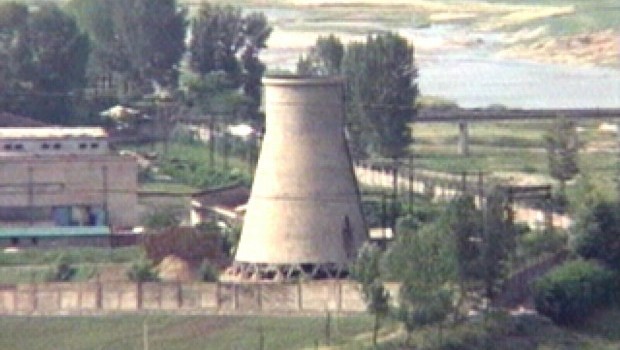
In this June 27, 2008 file photo from television, the 60-foot-tall cooling tower is seen before its demolition at the main Nyongbyon reactor complex in Nyongbyon, also known as Yongbyon, North Korea (AP Photo/APTN, File)
A uranium enrichment plant and a 5-megawatt graphite-rod reactor will resume operations after North Korea’s leadership said it will pursue the twin goals of economic and nuclear development, the Korean Central News Agency said, citing a spokesman of the General Department of Atomic Energy.
The reactor, which generates spent plutonium fuel rods, was closed in 2007 as part of a deal with the United States, South Korea, China, Russia and Japan to end North Korea’s nuclear ambitions in exchange for energy aid. Six-nation talks to dissuade the totalitarian regime from developing atomic weapons and testing missiles failed and haven’t been held since 2008.
Restarting the reactor follows statements by Kim that his country is in a state of war with South Korea and may launch preemptive nuclear strikes against the US, which North Korea has yet to prove it can do. The Obama administration yesterday said it has detected no unusual North Korean troop movements to back up its threats.
“Kim Jong Un is using the blackmail card again to scare the world into inviting the North back to the negotiating table with promises for aid or money,” said Kim Yeon Su, a professor at the Korea National Defense University in Seoul.
“The North’s primary aim is to cause fear and buy negotiating power while it refurbishes its atomic facilities, which may or may not be salvageable.”
North Korea has 24 to 42 kilograms of plutonium from the Yongbyon reactor, enough to produce four to eight nuclear bombs, according to estimates from Stanford University physicist Siegfried Hecker, who visited the facilities in 2010.
It will take North Korea from six months to a year to resume operations at Yongbyon, said Ham Hyeong Pil, a research fellow at the Korea Institute for Defense Analyses in Seoul.
Japan criticized Tuesday’s announcement, as did China, North Korea’s biggest trading partner and ally.
“We have noticed the remarks of the DPRK and express our regrets,” Foreign Ministry spokesman Hong Lei said in Beijing, using the acronym for North Korea’s official name, the Democratic People’s Republic of Korea. “We call on relevant parties to keep calm and exercise restraint.”
Since inheriting his position after his father Kim Jong Il’s death in December 2011, Kim has rebuffed international aid in favor of preserving a military-first policy to secure his legitimacy. His regime detonated an atomic weapon in February in defiance of tightening United Nations sanctions, and said US–South Korean military drills are a rehearsal for a nuclear attack against North Korea.
“Despite the harsh rhetoric we’re hearing from Pyongyang, we are not seeing changes to the North Korean military posture,” White House spokesman Jay Carney told reporters Monday in Washington. “We take it very seriously. But it is consistent with past behavior.”
South Korean Defense Ministry spokesman Kim Min Seok said Tuesday there are no signs of an impending missile attack, declining to confirm whether any activity has been detected at launch sites.
Carney said recent US military moves, which include deploying bombers and F-22 stealth fighters to South Korea as well as a shift in its missile defense system, are “prudent” given the situation. The Navy dispatched the USS John S. McCain, a guided-missile destroyer, to the southwest coast of the Korean peninsula, a US defense official said yesterday on condition of anonymity.
The annual US-South Korea military drills now under way run from March 1 to April 30.
North Korea’s parliament on Monday named economic reformist Pak Pong Ju premier, returning him to a post he held from 2003 to 2007 before he was demoted. The rubber stamp assembly met a day after Kim declared nuclear weapons development one of the top priorities for his impoverished country.
Nuclear arms can “never be abandoned” nor “traded with billions of dollars,” he said at a March 31 meeting of the ruling Workers’ Party Central Committee, KCNA reported.
Restarting the nuclear facilities, “if true, will be extremely unfortunate,” South Korean Foreign Ministry spokesman Cho Tai Young said Tuesday in Seoul, adding his government will keep close watch on the situation.
While North Korea has said it may shut the jointly run Gaeseong industrial zone in response to recent flights over the Korean peninsula by US stealth bombers, South Korean workers have continued to cross the border into the area, 150 of them Tuesday, the Unification Ministry said.
South Korea President Park Geun Hye Tuesday told officials the situation is grave and emphasized the need for strong diplomatic and military deterrence, her spokesman Yoon Chang Jung said in a statement on the presidential website.
Foreign Minister Yun Byung Se will meet US Secretary of State John Kerry in Washington Tuesday to discuss the North Korean threat. They will also discuss Park’s summit meeting with President Obama in the US next month, the Foreign Ministry said.
